A comparison of in-building coverage technologies
Modtech’s Portable BDA products solve radio dead zones!
The In-Building Working Group of the National Public Safety Telecommunications Council (NPSTC) published the “Best Practices for In-Building Communications” in November 2007 in which they cite:
“The need for reliable communications does not stop at the door of a building. Increasingly, public safety entities, commercial wireless service providers, and wireless users require reliable communications inside buildings and, where applicable, inside tunnels. For public safety, reliable coverage is often essential throughout a broad jurisdiction, including coverage on-street, in-building, and in-tunnels.”
Deployable communications systems are one of only three (3) primary approaches cited in the NPSTC best practices guide for achieving adequate in-building coverage. Modtech SIPS-BDA brings a new range of possibilities to deployable systems. Consider the features of SIPS-BDA and the corresponding benefits for transportable in-building communications systems summarized in table 1.
The National Fire Protection Association (NFPA) and International Code Council as well as may jurisdictions nationwide have adopted codes guiding in-building public safety communications. SIPS-BDA is perfectly positioned to meet these code requirements in a fully portable format.
SIPS-BDA features provide yet another set of key benefits to the engineering activities needed to design and implement an in-building system. Because of SIPS-BDA high energy and easy portability, it may be used to power amplifiers as well as test equipment during site survey and pre-installation testing phases. The hunt for optimal equipment locations may proceed interactively using live signaling portably powered by SIPS-BDA and its embedded power system. In this way, an entire building system may be established and powered up enabling full-fledged system acceptance testing before any resources are expended to run power wiring to the equipment. Only after system performance is fully verified, and only if the amplifier equipment is to become a fixed installation, is the expense of final power wiring undertaken. At this point a SIPS power system can provide required UPS functions and the SIPS cabinet can serve as a line demarcation box to which the fixed AC power will be terminated. Note, the number of SIPS battery modules may also be adjusted up or down depending upon the backup runtime required by the fixed installation.
| SIPS-BDA Feature | BDA System Benefit |
|---|---|
| High-energy lightweight lithium ion packs | Transport to and handle most easily at the event scene |
| Have more energy for longer standalone runtimes | |
| Scalable architecture | Choose just the right power conversion units to match the amplifiers voltage and current requirements |
| Use just the right number of energy modules to achieve desired runtime for each particular amplifier | |
| Optimize cost and weight without sacrificing required performance meeting mandated backup time or other requirements | |
| Intelligent, wireless, manageable, system | Receive email or contact closure alarms whenever maintenance or attention is required |
| Protect amplifiers from damage due to disconnected antennas | |
| Receive a clear indication of remaining runtime | |
| Aggregate and forward amplifier and associated equipment alarms | |
| Hot swappable, modular batteries | Extend operation as needed without interrupting operation |
| Share standard battery packs between supplies powering different equipment sets | |
| Safe, non-explosive, non-hazardous batteries and systems | Bring needed equipment from any location by fast air transport |
| Deliver systems to remote locations by air | |
| Avoid flammable fuels | |
| Avoid carbon monoxide or other dangerous exhaust gas by-products | |
| Expect quiet, vibration free operation | |
| Flexible, rugged, all-weather packaging options | Use outdoors away from hostile events in-building |
| Specify extra cabinet space to accommodate amplifiers, splitters, and other equipment | |
| Use enclosures as a mounting base for short antenna masts |
Table 1 – Benefits of SIPS used in deployable in-building communications systems
In summary SIPS portable power systems are building blocks for a fully portable, deployable in-building communications system. They also serve as an engineering tool used to quickly and inexpensively design and install an optimized fixed system. In the next section we’ll explore SIPS use to implement advantageous hybrid fixed / portable communications and electronics systems, as previewed in figure 1.
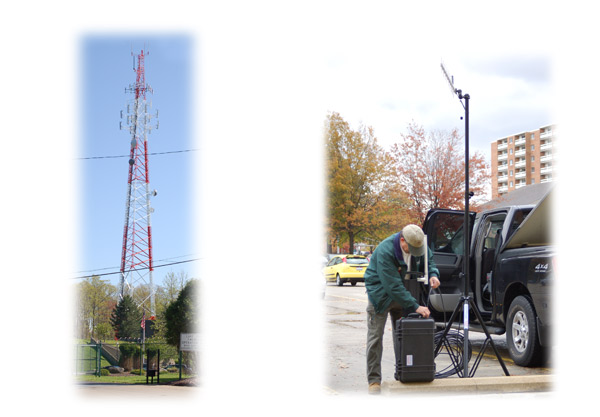
Figure 1 – A hybrid fixed / portable communications system, including a BDA and donor antenna.
Hybrid Fixed / Deployable Communications Systems using Scalable Intelligent Power Systems
The NPSTC describes three approaches to solving in-building or similar communications coverage challenges. Ideally, the infrastructure coverage is so omnipresent and signal strength everywhere so high that the issue is moot. Alternatively, a conventional, fixed, in-building system using indoor antennas, bi-directional amplifiers or signal boosters, and an external antenna is designed and built into the building, structure, or tunnel requiring it. The third approach is the deployable communications system wherein all elements of the needed system are contained in a portable kit that can be delivered to an event location as needed. Each of these three approaches has several advantages and disadvantages when aspects of the application in general and when a particular event scenario are considered including economy, reliability, spectrum integrity, etc. The NPSTC document “Best Practices for In-Building Communications” provide a thorough discussion of these approaches and their pros and cons.
Modtech proposes an approach that is a hybrid of the fixed and deployable approaches, which uses a combination of fixed and deployable components to maximally achieve the benefits of both while overcoming the shortcomings of each.
Figure 2 below shows a typical in-building communications system also known as a permanently installed system. NPSTC best practices guide describes this type of system in some detail. A key point is that all system components, multiversity or other type indoor antennas, coaxial cabling, uninterruptible power systems, bi-directional amplifiers or signal boosters, and outdoor directional donor antenna, are permanently dedicated to each building. Further all components with the exception of the outdoor antenna, are installed within the interior of the building.
Figure 3 depicts the so-called Deployable Communications Systems. Diametrically different than the permanently installed system, the deployable system packs all the system components into a transportable travel case. The NPSTC report discusses pros and cons of this approach. Historically, the deployable system can be very heavy and difficult to transport when enough lead acid batteries are kitted to support the battery runtime required. SIPS-BDA tactical BDA overcomes this limitation with its lightweight lithium ion power system. At least the indoor antenna must be carried into the target building while it remains tethered to the bi-directional amplifier via coaxial cable. The positioning of the indoor antenna within the building may therefore not be optimal.
Figure 4 is a step in the direction of a Modtech’s unique, hybrid, semi-portable in-building communications system called SIPS-BDA hybrid system.
Figure 5 depicts the full SIPS-BDA hybrid system. SIPS-BDA portable amplifier kit integrates the BDA(s), its power adapter(s), along with all alarming and monitoring functions into a common, rugged, weatherproof cabinet along with the SIPS lightweight lithium ion energy packs.
Figure 6 is a block diagram showing the spectrum of functions available in the SIPS-BDA portable amplifier kit.
Table 2 summarizes the advantages and disadvantages of various approaches described herein. SIPS-BDA tactical BDA system shares many of the advantages of the installed and hybrid applications plus several advantages over the installed approach. SIPS-BDA hybrid system has all of the benefits of both the fully-tactical and installed systems as well as advantages unique to the hybrid approach.
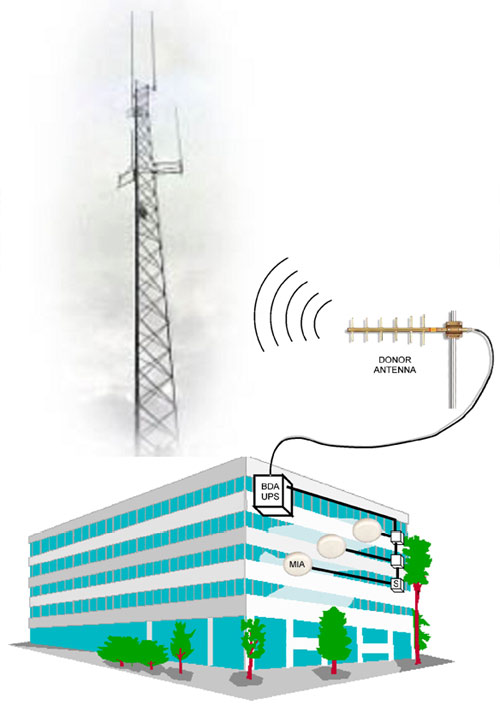
Figure 2 – Fixed In-building Communications System – indoor antenna array, splitters, in-building coaxial cable, uninterruptible power supply, bi-directional amplifier, and donor antenna system are all fixed within or upon the building.
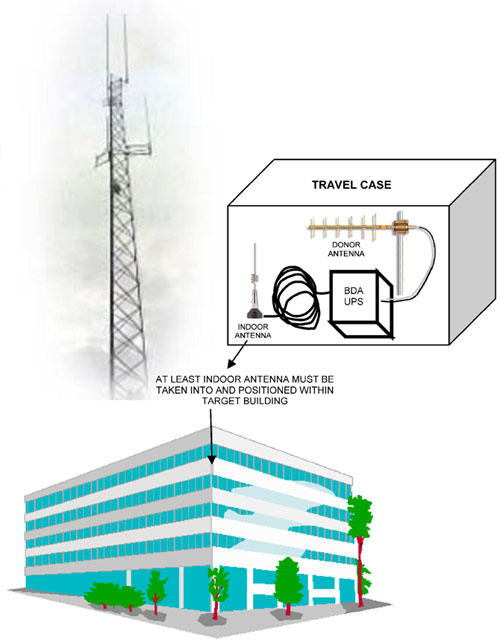
Figure 3 – A general, deployable in-building communications system – Indoor antennas, coaxial cables, uninterruptible power supply, bi-directional amplifier, and donor antenna system are all transported within a travel case. At least the indoor antenna must be carried into the building and connected via coaxial cable to the bi-directional amplifier which may remain outdoors. If substantial runtime is to be provided, and if lead acid batteries are used, the travel case will be very heavy.
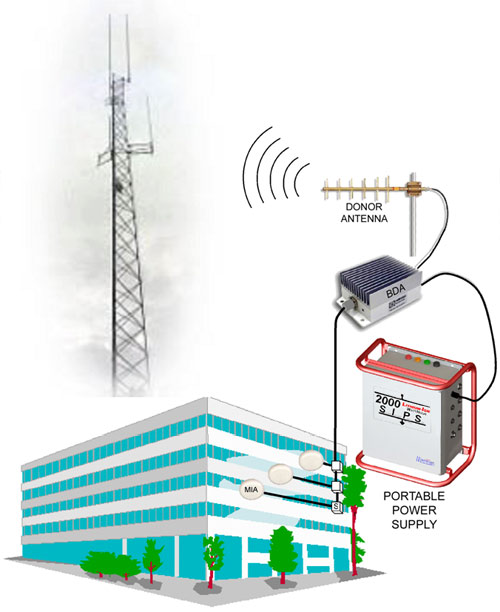
Figure 4 – Portable bi-directional amplifier system, a preliminary hybrid approach – indoor antennas, splitters, and in-building coaxial cable are installed fixed assets. Power supply and bi-directional amplifier are portable. Donor antenna system may be either fixed, portable, or both.
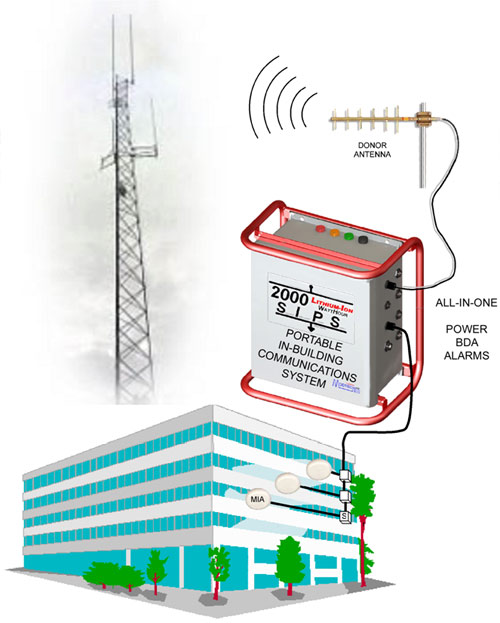
Figure 5 – SIPS-BDA hybrid system – bi-directional amplifier, alarming system, and power supply are integrated in a man-portable, tactical amplifier kit. Indoor antennas, splitters, and in-building coaxial cable are installed, fixed assets. Donor antenna system may be either fixed, portable, or both.
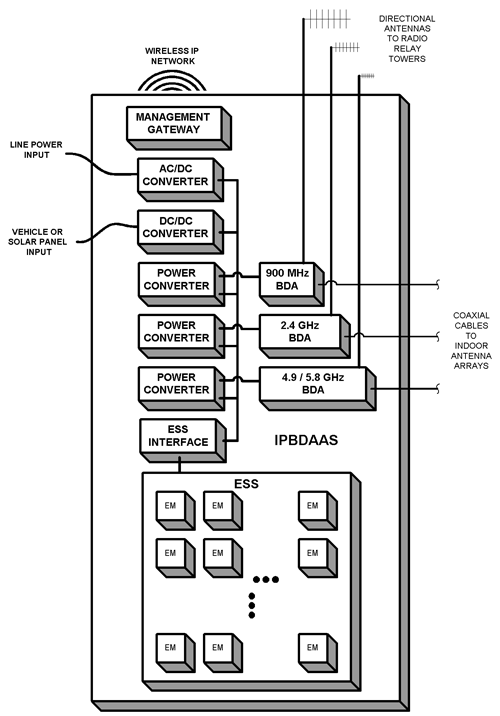
Figure 6 – SIPS-BDA tactical amplifier kit with many available options shown. The number of battery packs installed adjusts the amount of runtime. Power converters for each BDA system are included. Redundant power converters may be included as an option. If generator, line, vehicle, solar, or other power sources are available, they may be used to charge batteries and power the system. Batteries may be hot swapped to extend runtime without interruption of operation.
| Feature | Fixed In-Building Communications System | Deployable In-Building Communications System | Integrated Portable Bi-Directional Amplifier and Alarming System |
|---|---|---|---|
| Indoor Antennas, taps, and cabling are permanently installed in optimal, tested locations within the structure | Y | N | Y |
| Power system is self-contained, external, portable, and immune to destructive in-building events | N | Y | Y |
| Bi-directional amplifier(s) is external, portable, and immune to destructive in-building events | N | Y | Y |
| Entire system is engineered and tested to assure reproducible, acceptable performance at each event occurrence | Y | N | Y |
| Portable components including power, BDA, and monitoring and alarming system are fully integrated into one rugged enclosure and ready to operate when the box hits the ground, no assembly required | N/A | N | Y |
| Battery system is lightweight, modular, lithium ion technology including hot-swap batteries and detailed performance and status monitoring | N | N | Y |
| The cost of expensive hardware including power system and BDA(s) is amortized across many target buildings | N | Y | Y |
| Amplifier and power system upgrades are more easily performed because there are fewer, portable systems to address | N | Y | Y |
| Batteries and other portable equipment is standardized and may be shared between different response teams | N | N | Y |
| A lack of line power or depleted batteries are NOT a problem, continuity of system operation is assured | N | N | Y |
| Continuous monitoring and alarming for power and amplifier components is integrated into the system and accessible via wireless internet access using any web browser from any PC | maybe3 | N | Y |
| Donor antenna is permanently installed in optimal location at site | maybe4 | N | optional5 |
| Donor antenna is easily realigned in the event of relay failure | N | Y | Y |
| The system will be present and operational when first responders arrive on scene | N1 | N2 | N2 |
| No additional equipment need be transported to the scene | Y | N | N |
Table 2 – The pros and cons of various approaches to in-building communications coverage enhancement.
Notes:
- A fixed system may be inoperative as a result of a power failure or destructive in-building event.
- A portable system may not have arrived at the scene yet.
- The fixed system may not have monitoring and alarming functions installed and may be expensive to upgrade.
- Although the donor antenna is fixed, it may not be optimally located or aligned due to changing environmental conditions or other external variables.
- The portable system may connect to a fixed donor antenna on site but may also be flexibly connected to a portable antenna if needed or desired.
